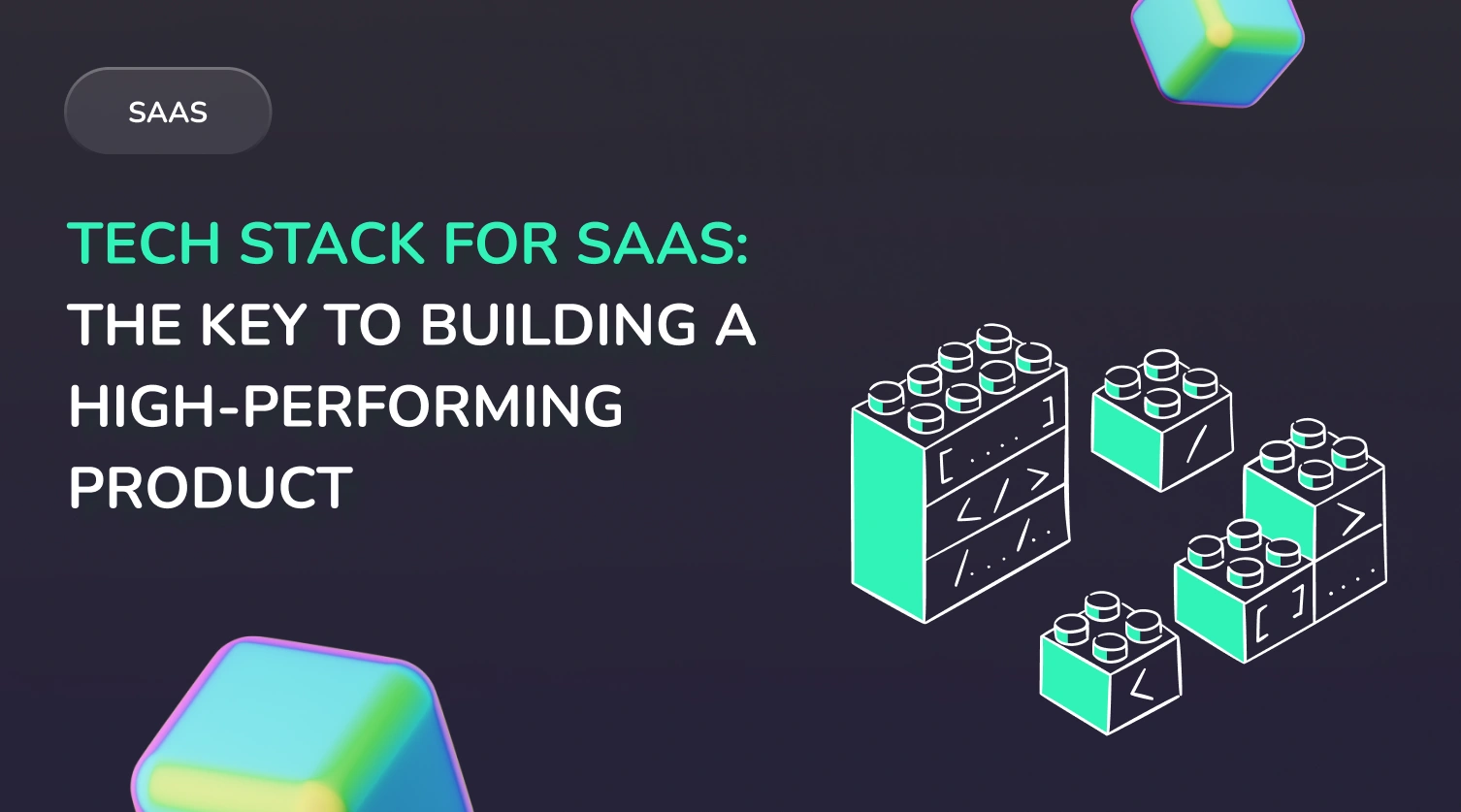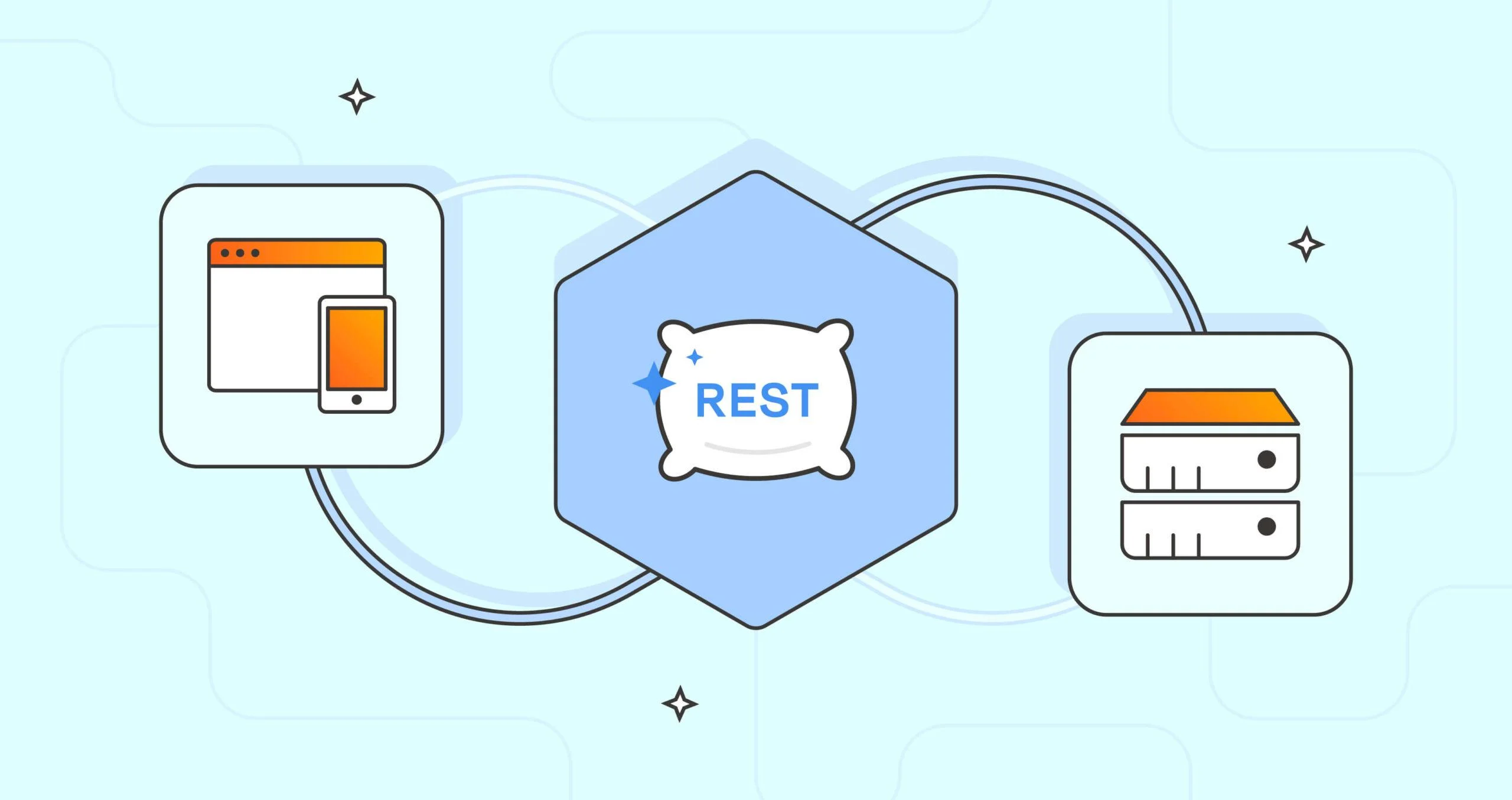
You probably know the feeling when your startup idea seems so strong that you want to launch it right now. Your team is excited, the market is researched, the niche is clear, and even your first users are already waiting. However, once you reach the technical stage, everything seems to freeze.
How do you choose technologies that won’t just make your product work, but will also help it grow, scale, and stay competitive in the long run?
For many founders, this stage becomes one of the most unpredictable in SaaS product development. Some rely on the opinion of the first developer they meet. Others take advice from forums. And some opt for a “trendy” SaaS tech stack simply because “everyone else is doing it.” However, the truth is that there is no single best tech stack for SaaS that fits all cases.
What does exist is a smart way of thinking, a strategy you can follow to ensure your choice supports your goals throughout the SaaS lifecycle.
In this article, we won’t just tell you which SaaS programming languages, frameworks, and databases are popular right now. We’ll explain how to think when selecting a scalable tech stack for your SaaS product.
We’ll keep it simple, no overwhelming jargon, because we respect your business intuition. In the end, your SaaS framework choice isn’t only about technology. It’s about the future of your product. And that future depends on making the right decisions from the very beginning, starting with a modern technology stack and a reliable saas development framework.
Whether you’re planning a quick MVP or a full-scale solution, choosing the best framework for saas applications will define your speed, flexibility, and long-term success. A smart saas software stack today means fewer surprises tomorrow. That’s the real power of a well-chosen saas stack.
Understanding the Requirements of Your SaaS Product
When choosing a saas technology stack, many founders rush into it wanting to start development as soon as possible so they “don’t miss the moment.” But this is exactly where you need to pause and ask yourself the most important question: what exactly should your product be able to do to be useful, user-friendly, and successful?
The answer to this question will become the foundation for choosing your saas tech stack.
Who are your users, and what do they need?
Let’s say you’re launching a platform for small business accountants. Their expectations will be very different from those of designers, marketers, or teenagers. They won’t tolerate a complex interface, and definitely not “broken” reports at the end of the quarter. So right away, you know: you need reliable technologies with strong logic, precision, and simplicity.
Your target audience is not just about “age and job.” It also includes how quickly they make decisions, what they expect from a UI, their digital skills, and even the devices they’ll use. If your product is meant for people on the go, a mobile version becomes essential. This impacts your SaaS development framework and whether you opt for cross-platform development, native apps, or a PWA.
What problems does your product solve?
Functionality is not a wishlist of “we want everything.” It’s the core of your SaaS. For example, if you’re building a CRM, the essential features are contact management, communication history, and task automation.
This is where defining your MVP is key — what needs to go live first to make the product valuable, and what can wait. Considering the SaaS product development framework early on helps you plan an architecture that supports future growth, saving you time and money on rework.
What if the product scales?
Scalability is one of the most important factors for saas solutions development. Today, you might have 100 users next year, it could be 100,000. Or more.
Some technologies perform well with small loads but fail under pressure. Others are too heavy for a lean startup. That’s why it’s important to be realistic: what is your growth potential, where are the bottlenecks, and how fast should your architecture scale?
A scalable tech stack is key here, from your database choices to cloud infrastructure. Making the right decision now prepares your saas framework for real growth.
Do you need integrations?
Modern SaaS products rarely work in isolation. Integrations with payment gateways, messengers, CRMs, accounting tools, Google Workspace, Slack, or Zapier are expected.
The more integrations you plan to have, the more demanding your saas stack becomes. You’ll need technologies that support APIs, offer flexible architecture, and allow scalable integration. This affects your backend choices, queue systems, and data formats.
What about security?
If your SaaS product will handle personal data, transactions, healthcare, or financial info, security requirements grow significantly.
You’ll need to consider authentication and authorization (like OAuth or JWT), encryption (both at rest and in transit), and compliance standards like GDPR, HIPAA, or SOC 2. These needs will influence your choice of saas software stack, since not every saas programming language or tool is easily customizable for strict regulations.
Before you open the list of programming languages and frameworks, take time to answer these business-related questions. It’s not just “prep work.” It’s the foundation.
Because choosing the best tech stack for saas is not about trends or popularity, it’s about fit. Tailored for your product, team, market, and goals. The better you understand this, the easier it will be to select a modern technology stack that will help you build a SaaS product ready for long-term growth.
Key Factors When Choosing a SaaS Tech Stack
Once you’ve handled the initial steps in choosing a tech stack, it’s time to move forward. Think of it like choosing a foundation for a house. Everything seems similar until construction begins. Then suddenly, you realize, “we can’t add a second floor here,” or “we can’t connect electricity,” or even “this was made for a different climate.” In digital products, those “surprises” happen when you grow, face security challenges, or try to connect a third-party service, and it doesn’t work.
To avoid these issues, let’s review the most important factors to consider from the outset when selecting your SaaS technology stack.
Scalability: Can You Grow Without Pain?
At the beginning, everything runs smoothly. However, as your user base grows, so does the pressure: higher traffic, a stretched database, and slower APIs. If your saas stack isn’t built for scaling, you might need to rewrite everything later. That’s expensive, slow, and painful.
Architectures based on microservices and cloud platforms, such as AWS, GCP, or Azure, support flexibility and growth without requiring a rebuild of your product. Tools such as Kubernetes, Docker, or serverless systems help you stretch your saas software stack depending on the load.
Choose a scalable tech stack that supports horizontal scaling (adding more servers), not just vertical (more powerful hardware). It’s more cost-effective and reliable in the long run.
Development Speed: How Fast Can You Launch?
For startups, it’s not only about features, but also about time to market. The faster you launch, the faster you get user feedback, validate ideas, and start earning money. That’s why choosing a saas development framework and tools that speed up the process is essential.
For example, Node.js and Ruby on Rails are popular choices for quick starts. Low-code or no-code platforms are great for prototypes or admin dashboards. React, Vue.js, and Next.js help accelerate frontend development with large ecosystems of ready-to-use components.
Advice: Use tools with rich documentation and pre-built libraries, as they can save you weeks or even months during early SaaS solutions development.
Security and Compliance: Playing by the Rules
If your product handles user data, especially in finance, healthcare, or education,n you must follow strict data privacy standards like GDPR, HIPAA, or PCI DSS.
Your saas product development framework must support:
- Data encryption (in transit and at rest)
- Role-based access control
- Secure authentication (OAuth2, SSO, 2FA)
- Audit logs
Some technologies, like Django or Laravel, come with strong security features out of the box. Tools like Auth0 or Firebase Auth can help manage secure access easily.
Remember: Treat security as a core part of your saas lifecycle, not an optional feature. It’s much cheaper to build it in than to recover from a breach later.
Cost: Don’t Just Count Today — Plan for Tomorrow
Open-source stacks may look like a great deal, but sometimes “free” can cost more in the long run. You might end up paying for plugins, support, or hiring rare specialists.
When planning your budget, consider:
- Cloud infrastructure costs (e.g. AWS Lambda is cheap at first, but costly at scale)
- Licensing fees (for example, some databases like Oracle require paid licenses)
- Developer hiring costs (less common saas programming language = more expensive experts)
- Future maintenance and update costs
It’s important to look at the total cost of ownership (TCO), not just the launch cost. Choose the best tech stack for saas based on long-term goals, not only short-term savings.
Developer Availability and Community Support
A cutting-edge technology is great, but it becomes a problem if you can’t find developers for it in six months or in another country. The bigger the community, the easier it is to:
- find help on forums and GitHub,
- hire developers faster,
- use ready-made plugins, tools, and patches.
For example, JavaScript/TypeScript, Python, React, PostgreSQL, and Docker are not just powerful tools — they are also part of a modern technology stack with huge global communities. That significantly reduces risk for your saas product development framework.
Always check GitHub activity, frequency of releases, the number of stars, and questions on StackOverflow. These are good signs of how “alive” a saas framework or library really is. Choosing a widely adopted saas programming language also makes long-term support easier.
Integration Capabilities
Almost every SaaS product today needs to connect with other systems: CRMs, payment services, email platforms, analytics tools, and more. To avoid bottlenecks, your SaaS stack must easily support API integrations, handle data formats such as JSON or GraphQL, and offer high-quality SDKs.
Frameworks focused on REST or GraphQL, and tools like API gateways or middleware are essential for smooth integrations. In the early stages of saas solutions development, tools like Zapier can connect third-party services without complex coding. This flexibility is crucial in the saas lifecycle.
 Remember, picking a saas development framework isn’t just about the saas programming language — it’s a strategic decision that affects everything from scalability to compliance. It can even impact your peace of mind.
Remember, picking a saas development framework isn’t just about the saas programming language — it’s a strategic decision that affects everything from scalability to compliance. It can even impact your peace of mind.
SaaS Tech Stack Overview in 2025
Your saas technology stack is not just a list of tools — it’s the foundation of your product. It influences development speed, scalable tech stack options, security, maintenance costs, and long-term product growth.
Let’s explore the most popular saas software stack options developers are choosing in 2025 and why they’re effective.
MERN Stack: MongoDB, Express.js, React, Node.js
MERN is one of the most popular stacks among startups, and for good reason.
- MongoDB is a document-oriented database that easily scales and fits flexible, fast-changing data structures.
- Express.js is a minimalist framework for Node.js, ideal for building backend logic fast.
- React is a library by Meta (Facebook) for building dynamic user interfaces.
- Node.js allows developers to use JavaScript for both frontend and backend, simplifying the saas tech stack.
MERN is often considered the best tech stack for SaaS MVPs due to its rapid development speed, strong community support, and scalable architecture. It’s a great fit if you’re building an interactive web product with plans to scale.
MEAN Stack: MongoDB, Express.js, Angular, Node.js
MEAN is similar to MERN, but it uses Angular instead of React.
- Angular is a Google-developed framework that offers a strong architectural pattern right out of the box.
- Unlike React, Angular enforces structure, which is useful in large teams and long-term projects.
MEAN provides a unified JavaScript-based saas software stack. It’s an excellent choice for enterprise SaaS applications that need clear architecture and long-term maintenance.
LAMP Stack: Linux, Apache, MySQL, PHP
LAMP is one of the oldest and most reliable stacks in web development.
- PHP is still widely used in platforms like WordPress, Laravel, and OpenCart.
- MySQL is a relational database management system (RDBMS) ideal for storing and managing structured data.
- LAMP runs on most hosting platforms without a complex setup.
This SaaS stack is best suited for building a simple SaaS product, landing page, or admin panel that doesn’t require a highly flexible architecture. It’s cost-effective, stable, and supported by a massive developer community — a key part of a low-risk saas lifecycle strategy.
.NET Stack: .NET, C#, SQL Server
If your goal is to build a high-performance and secure enterprise-level application, then the .NET stack is a strong option. It offers excellent performance, reliability, and security — all essential features for enterprise SaaS solutions development.
Supported by Microsoft, it’s regularly updated and well-documented.
C# is a strict and powerful saas programming language, ideal for building large and complex systems.
The .NET saas development framework also integrates well with cloud solutions like Microsoft Azure, making it a smart choice for projects that must meet strict compliance standards such as HIPAA or GDPR.
This SaaS framework is highly suitable for SaaS platforms in industries such as finance, healthcare, logistics, or any corporate-focused product that demands stability and scalability throughout the SaaS lifecycle.
Serverless Architectures: AWS Lambda, Azure Functions, Google Cloud Functions
Serverless doesn’t mean there are no servers — it simply means you don’t have to manage them. This approach reduces infrastructure costs, minimizes DevOps tasks, and is perfect for creating a scalable tech stack.
- You just write a function, deploy it, and the cloud handles the rest — automatically scaling based on demand.
- You pay only for actual usage — if there’s no load, there’s no cost.
This architecture is ideal for applications with variable workloads, fast iterations, and easy integrations — all important in the modern technology stack for SaaS.
📌 It’s essential to understand that there’s no one-size-fits-all SaaS technology stack. The best choice depends on your product’s needs, team experience, and long-term business goals. Some teams value fast development, others prioritize security or scalability.
Ideally, choosing the best tech stack for saas should not be based solely on trendy tools, but on growth plans, budget, and the real challenges your SaaS is solving.
If you don’t yet have a technical team, it’s better to discuss your saas stack with experts during the planning phase. This can help avoid costly rebuilds later and allow you to launch your saas software stack faster, more securely, and with more confidence.
Modern Tools and Technologies for SaaS Product Development
Building SaaS in 2025 is no longer just about coding; it’s about building a comprehensive platform. It’s about creating a full SaaS product development framework, where each tool plays a role in scalability, performance, and user experience.
You don’t just want the best framework for saas applications — you want tools that solve real problems and help your business grow.
Frontend: Next.js with shadcn/ui — A Modern Approach to Interfaces
Next.js has become the go-to saas framework for building fast, SEO-friendly, and responsive interfaces. It’s built on top of React and supports server-side rendering (SSR), which improves speed and search engine indexing.
The Shadcn/ui library offers flexible, customizable UI components that speed up design and maintain a consistent, intuitive interface.
Why does this matter?
Because the user interface is the first thing people see. If it feels slow or outdated, chances are, users will leave — even if your backend is flawless.
Backend: .NET 8 on Azure — Reliability, Speed, and Security
.NET 8, combined with Microsoft Azure cloud infrastructure, forms a powerful saas tech stack for building secure, scalable, and high-performance backend systems.
It handles heavy traffic, delivers fast responses, and supports full CI/CD pipelines, auto-scaling, and built-in monitoring — all out of the box.
This setup is ideal for teams building long-term B2B SaaS platforms, especially in regulated sectors. It’s one of the most reliable components in today’s saas software stack.
Databases: PostgreSQL and Supabase – flexibility and modern tools
PostgreSQL is one of the most powerful and flexible open-source relational databases. It’s perfect for structured data, supports advanced queries, transactions, and extensions, making it a popular choice in the saas software stack.
Supabase is basically “Firebase for PostgreSQL” — a cloud platform offering ready-to-use APIs, authentication, and real-time features. It’s a great option if you’re aiming to speed up your saas solutions development without writing too much custom code.
When to use them?
If you need flexibility and full control over your data, go for PostgreSQL as part of your saas tech stack. Supabase works well for MVPs and fast prototyping during the early stages of the saas lifecycle.
DevOps and Cloud Services: Docker, Kubernetes, CI/CD
You can write perfect code, but without proper deployment and automation, no one will see it.
Docker packages your app into a “container” — an isolated environment where everything works consistently, no matter where it’s deployed. It’s a solid tool in any saas technology stack.
Kubernetes helps manage containers, auto-scales apps under load, and ensures system reliability — a great choice for a scalable tech stack.
CI/CD (Continuous Integration / Continuous Deployment) tools test, build, and release your code automatically. This saves hours of manual work and reduces errors, accelerating saas product development framework workflows.
Real benefit: Your updates go live faster, more frequently, and with fewer risks — a key advantage in saas stack management.
Security: OAuth, JWT, Auth0 – Reliable Authentication and Authorization
Since most SaaS apps work with sensitive user data, security should be a top priority in your saas development framework.
- OAuth 2.0 is the industry standard for delegated authorization, such as signing in with Google or Facebook.
- JWT (JSON Web Tokens) allows secure data exchange between client and server.
- Auth0 is a ready-to-use cloud solution for authentication — it lets you easily set up login, signup, MFA, and more.
Why does it matter?
Because one weak point in your security system can cost you clients, damage your reputation, and result in financial losses. Investing in secure components is vital for any saas framework or the best framework for saas applications.
Wrapping up
Choosing the right technologies isn’t about following trends. It’s a strategic decision that affects how fast you launch, how smoothly you grow, and how secure and stable your product is. Good tools are not a luxury — they’re the foundation of healthy saas solutions development.
If you’re feeling lost with all the tools, stacks, and acronyms, don’t worry. That’s what experienced product and tech partners are for. We know how to help you choose the best tech stack for saas, guide your saas lifecycle, and turn your idea into a real, working product.
Subscribe to our blog


